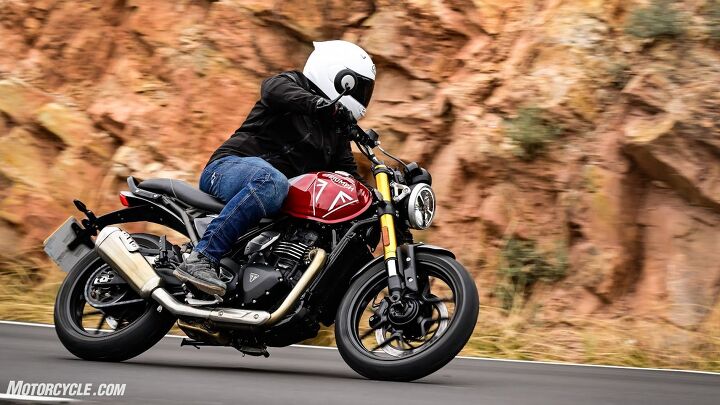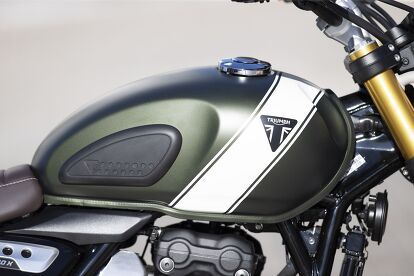2024 Triumph Speed 400 & Scrambler 400 X Review – First Ride

Two new lightweights that deliver vastly different experiences
The folks in Hinckley have been busy in recent years bolstering Triumph’s reputation as a two-wheeled powerhouse of tech and performance. In the past six months or so, however, it’s also been releasing new models across its product line and entering highly competitive segments that are new to the British marque in the modern era. Now, with its new 398cc liquid-cooled, four-valve Single, the company is poised to attack the lightweight/entry-level class.
Triumph has set out to build an affordable motorcycle that retains the level of quality that has become synonymous with the brand. To compete in this price sector, the new 400s are the first motorcycles produced in partnership with India’s Bajaj Auto – a partnership that has allowed Triumph to set an MSRP of $4,995 for the Speed 400 and $5,595 for the Scrambler 400 X. Has Triumph sacrificed in any critical areas to meet a price point? We hopped on a short flight to Valencia, Spain directly from the Ducati DesertX Rally press event in Morocco to find out.
TR Series
Both models are powered by the all-new “TR-series” engine. Named for the TR5 Trophy that Triumph raced at the 1948 International Six-Day Trial, the TR-series engine is a fuel-injected, liquid-cooled, 398cc Single with a four-valve DOHC cylinder head and a counter-rotating balancer shaft. Triumph claims a peak output of 39.5 hp at 8,000 rpm and 27.7 lb-ft. at 6,500 rpm. While we expect those numbers to be a bit lower at the rear wheel on the MO dyno, it does slot the engine’s performance in-line with other power plants in the 400cc range.
Squirting through traffic on our way out of Valencia was easy enough thanks to the short gearing on the 400s, but it’s almost too short as I’d shoot through the revs quickly in first gear. In most situations I found myself short shifting through first to get to second immediately. Thankfully, between the light clutch pull and the slick six-speed gearbox, shifting was always solid and smooth with the slipper clutch ready to handle things if you made a mess of your downshifts.
On the highway, vibes become readily apparent north of 6,000 rpm which is, perhaps not coincidentally, where the meat of the new engine’s power begins to really come into play. With the engine solid-mounted to the chassis, the single counterbalancer has its job cut out for it and doesn’t quite keep up toward the latter half of the rev-range. On canyon roads, there was quite a bit of vibration felt while keeping our... ahem, spirited pace as the 9,500 rpm redline was never far away. In that case, the vibes aren’t bothersome, but while droning along at 75 mph or more on the freeway, it’s hard to think about much else.
In terms of electronics, Bosch brings switchable traction control to both models with the Scrambler 400 X getting an “Off-road” ABS mode that disables ABS entirely. All this information and more can be found in the dash which uses a combination of a classic analog speedo complete with dummy lights and LCD display. Everything was fairly straightforward here, although when switching TC or into the Off-road ABS mode, there is a specific amount of time one must hold down a button. This took more than a few folks more than a few tries to get the hang of.
The steel frame and bolt on subframe are shared between the two models, as are the 43 mm fork and monoshock. The difference here is that the Scrambler 400 X gets 0.4 more inches of travel up front and 0.8 inches more travel out back resulting in 5.9 inches of travel at both ends. Triumph has also added two links to the chain on the X and simply pulled the rear axle back in the cast aluminum swingarm and extended the headstock out a bit to give the Scrambler a bit more stability.
Here’s where we start getting into the differences between the two 400s that end up delivering a substantially different riding experience.
Scrambler 400 X
The Scrambler 400 X sets itself apart with a 19-inch front wheel leading a 17-incher in the rear – both cast aluminum and wrapped in aptly named Metzeler Karoo Street tires – they’re fine for scraping foot pegs on-road, but don’t offer much off-road performance. To accommodate the larger front wheel, Triumph extended the headstock out by 0.8 inches. This, coupled with the larger wheel, made the bike handle somewhat awkwardly at low speed, but not so much that one couldn’t get used to it.
I mentioned the minimal extra suspension which results in a bit of extra ground clearance, but also a taller seat height at 32.8 inches. That’s nearly two inches taller than the Speed 400’s saddle. The steel handlebar is also just over an inch wider than its sibling and uses a taller riser than the Speed. Using a somewhat crude, but simple foot peg bracket, the Scrambler’s footpegs come out slightly wider from the bike in addition to being a bit lower and more forward. All of this lends to the Scrambler 400 X feeling like a full-size motorcycle whereas the Speed feels closer to a three-quarter bike. Of course, that’s for better or worse depending on your size or what you’re looking for. During our short stint off-road, the seat height made some of the less experienced riders a bit uneasy.
While railing the bikes through mountain roads, the Scrambler 400 X’s geometry and accoutrement do lend to slower handling, but that didn’t stop me from hustling the bike through non-stop switchbacks and hairpins – it was only once I jumped on the Speed that I realized just how much quicker it could be, but more on that in a tic.
One surprising bit was the front brake. Triumph used a slightly larger 320 mm single rotor on the Scrambler’s front wheel but opted to use a pad with less initial bite to make it easier to use on loose surfaces. The four-piston ByBre caliper will get the job done, but the lack of initial bite and mediocre stopping power had me pulling the lever much closer to the grip than I would have liked.
The suspension also ended up surprising, albeit in a different way. Typically, for a bike playing in this realm, suspension is a weak point – whether it’s softly sprung or crudely damped. The Scrambler 400 X suspension isn’t mind-blowing, but the fact that it can handle a fire road and aggressive street riding while not constantly blowing through the stroke or pogo-ing down the road is, well, surprising. The fork held up well under hard trail braking and never did anything unexpected. Likewise, the shock was compliant throughout the ride, too – even with 200-plus pounds of ham-fisted rider.
2024 Triumph Scrambler 400 X
Editor Score: 83.25%
Engine | 15/20 | Suspension | 13/15 | Transmission | 8.5/10 |
Brakes | 6/10 | Instruments | 4/5 | Ergonomics | 9/10 |
Appearance | 9/10 | Desirability | 9/10 | Value | 9.75/10 |
Highs
- Feels like a full-sized motorcycle
- Comfortable ergonomics
- Packaging and attention to detail is what we’ve come to expect from Triumph
Sighs
- Any initial bite out of the front brake pads would’ve been nice
- The engine feeds vibration through the entire motorcycle after 6,000 rpm
- Navigating the few electronics takes some getting used to
Speed 400
After swapping bikes at lunch once the road gave way into the mountains and we began to get to the good stuff, I caught myself turning into the first few bends much too quickly, needing to correct mid-corner. This was, of course, after having ridden the Scrambler 400 X all morning. The difference in handling between the two is considerable thanks to the Speed’s smaller front wheel, shorter wheelbase, and steering geometry – and the Speed 400 manages to do this without being twitchy in the least.
Another big difference that took some getting used to was braking performance. Despite the 20 mm smaller front rotor, the sintered brake pads that come stock on the Speed provide immediate – bordering on too immediate – bite and somehow didn’t feel as soft at the lever once you’re into the meat of the braking power. Triumph did tell us that the pads are swappable between the bikes, which would be the first thing I’d suggest Scrambler owners do. It’s an absolute night and day difference.
As mentioned previously, the Speed 400 feels like a three-quarter bike, or maybe five-sixths. Whatever fraction we land on, I mean that even for a guy who’s 5-foot 8 inches with a 30-inch inseam, the motorcycle feels small. That’s not necessarily a bad thing though, because it makes managing the bike that much easier. While the cockpit is tighter than the Scrambler’s, it never felt cramped for me and I enjoyed the ride on the highway just as much as I did in the canyons, despite the vibration. Bigger folk might have another take. The Speed’s 31.1-inch seat height also makes throwing a leg over it, or getting a foot down at a stop easy, which is a big confidence boost for new or shorter riders. Both bikes can maintain American highway speeds, though you’ll likely need to drop out of sixth gear if you plan on overtaking.
2024 Triumph Speed 400
Editor Score: 85.75%
Engine | 15/20 | Suspension | 13/15 | Transmission | 8.5/10 |
Brakes | 8.5/10 | Instruments | 4/5 | Ergonomics | 8.75/10 |
Appearance | 9/10 | Desirability | 9/10 | Value | 10/10 |
Highs
- Super agile around town or on mountain roads
- The front brake setup feels much better with the Speed’s pads
- As mentioned previously, the Speed is a good-looking motorcycle, from afar, or up close
Sighs
- The Speed feels like a ¾ bike, which may be a pro for some
- Vibrations come through in the same way on both bikes
What do you want?
Honestly, it’s a fairly simple conversation for those looking at the new Triumph 400s. Do you have any interest in going off-road? Are you a bigger person or want a bike that feels larger? The Scrambler 400 X will make you happy with its ergos and the fact that you can disable TC and ABS. Plan to spend your time on the road beboppin’ around town or cruising mountain roads? The Speed is adept at all of that.
In its new partnership with Bajaj, Triumph has managed to build two motorcycles that burgeoning and seasoned riders alike will be proud to own. Both machines do an excellent job at hiding all of the things you don’t want to see (as Triumph is wont to do) – and both offer three different color options and a slew of accessories. Per Triumph’s studies, cost of ownership is lower than its competitors and service intervals are set at 10,000 miles. At the price Hinckley’s managed to offer these two machines, I won’t be surprised if Triumph sells a (metric) ton of them. For a new rider or someone looking for a classic small displacement motorcycle, you’d be hard-pressed to find a better value.
In Gear

- Helmet: Arai Contour-X
- Jacket: Fly Carbyne
- Gloves: Racer Mickey
- Jeans: Alpinestars X Diesel AS-DSL Daiji
- Boots: Fulton Air
Speed 400 | Scrambler 400 X | |
|---|---|---|
Engine Type | Liquid-cooled, 4 valve, DOHC, single-cylinder | |
Displacement | 398 cc | |
Bore | 89.0 mm | |
Stroke | 64.0 mm | |
Compression | 12:01 | |
Maximum Power | 40 PS / 39.5 bhp (29.4 kW) @ 8,000 rpm (claimed) | |
Maximum Torque | 37.5 Nm @ 6,500 rpm (claimed) | |
Fuel System | Bosch electronic fuel injection with electronic throttle control | |
Exhaust | Stainless twin-skin header system with stainless steel silencer | |
Final Drive | X-ring chain | |
Clutch | Wet, multi-plate, slip & assist | |
Gearbox | 6-speed | |
Frame | Hybrid spine/perimeter, tubular steel, bolt-on rear subframe | |
Swingarm | Twin-sided, cast aluminum alloy | |
Front Wheel | Cast aluminum alloy 10 spoke, 17 x 3 in | Cast aluminum alloy 10 spoke, 19 x 2.5 in |
Rear Wheel | Cast aluminum alloy 10 spoke, 17 x 4 in | Cast aluminum alloy 10 spoke, 17 x 3.5 in |
Tires | Metzeler Sportec M9RR | Metzeler Karoo Street |
Front Tire Size | 110/70 R17 | 100/90 R19 |
Rear Tire Size | 150/60 R17 | 140/80 R17 |
Front Suspension | 43mm upside down Big Piston forks. 5.5” (140mm) wheel travel. | 43mm upside down Big Piston forks. 5.9” (150mm) wheel travel. |
Rear Suspension | Gas monoshock RSU with external reservoir and pre-load adjustment. 5.1” (130mm) wheel travel | Gas monoshock RSU with external reservoir and pre-load adjustment. 5.9” (150mm) wheel travel |
Front Brakes | 300mm fixed disc, four-piston radial caliper, ABS | 320mm fixed disc, four-piston radial caliper, ABS |
Rear Brakes | 230mm fixed disc, floating caliper, ABS | 230mm fixed disc, floating caliper, ABS |
Instruments | Analogue speedometer with integrated multi-function LCD screen | |
Length | 80.9” (2056 mm) | 83.4” (2117 mm) |
Width (Handlebars) | 31.3” (795 mm) | 32.5” (825 mm) |
Height (Without Mirrors) | 42.3” 1075 mm | 46.9” (1190 mm) |
Seat Height | 31.1” (790 mm) | 32.8” (835 mm) |
Wheelbase | 54.2 (1377 mm) | 55.8” (1418 mm) |
Rake | 24.6° | 23.2° |
Trail | 4” (102 mm) | 4.3” (108 mm) |
Wet Weight* | 375lb (170kg) | 395lb (179kg) |
Fuel Tank Capacity | 3.43 Gallons (13 L) | |
We are committed to finding, researching, and recommending the best products. We earn commissions from purchases you make using the retail links in our product reviews. Learn more about how this works.
Become a Motorcycle.com insider. Get the latest motorcycle news first by subscribing to our newsletter here.

Ryan’s time in the motorcycle industry has revolved around sales and marketing prior to landing a gig at Motorcycle.com. An avid motorcyclist, interested in all shapes, sizes, and colors of motorized two-wheeled vehicles, Ryan brings a young, passionate enthusiasm to the digital pages of MO.
More by Ryan Adams




















































































Comments
Join the conversation
It's the vibration that would kill the fun for me. Too bad they couldn't isolate the engine from the frame a bit.
The Speed very much interests me as a second or third motorcycle. The price is hard to believe. But you get Indian-built quality and that is what scares me. There is no long-term reliability information on these bikes at this time.
The TC is just bizarre and unnecessary on a low-power bike like this. ABS is also unnecessary, but required in some locations I am sure. Keep the TC and use that money elsewhere - build it in a higher quality country even like China, do better to negate the vibrations which sound like they could be a deal breaker, give it a better dash or make it even lighter weight by using higher quality parts in certain places.